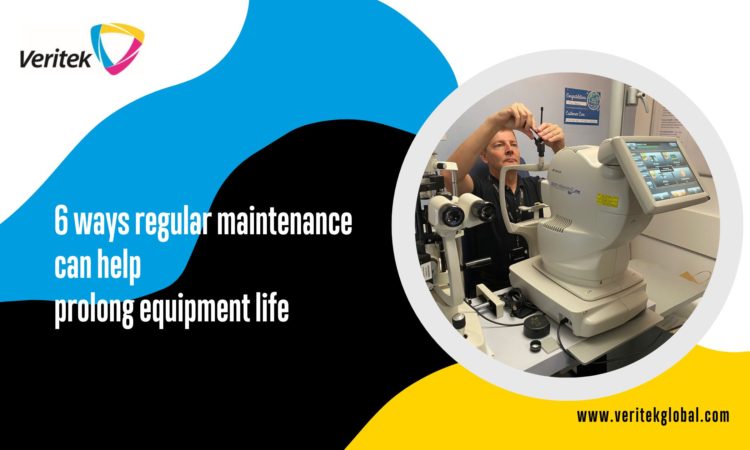6 ways regular maintenance can help prolong equipment life

Prolonging equipment life with regular maintenance benefits manufacturers by:
- Generating repeat business
- Fostering brand loyalty
- Building a positive reputation
- Saving costs
But most importantly, prolonging equipment life with regular maintenance helps manufacturers achieve sustainability goals by reducing waste and pollution generated by manufacturing and transporting new equipment, conserving natural resources, and reducing energy consumption and greenhouse gas emissions.
Some of the ways OEMs’ customers can prolong equipment life with regular maintenance include:
1. Scheduling regular preventative maintenance
The aim is to identify and fix any potential issues before they become significant problems.
In addition to prolonging equipment life, regular scheduled preventative maintenance helps manufacturer’s customers:
Reduce downtime: By identifying and addressing potential issues before they cause equipment failure, preventative maintenance can help to reduce the amount of downtime caused by equipment breakdowns.
Increase equipment efficiency: Regular preventative maintenance ensures equipment runs at peak efficiency, reducing energy consumption and increasing productivity.
2. Regularly calibrating equipment
Regular calibration ensures equipment functions within the manufacturer’s specifications, complies with regulations and industry standards, and promotes safety, quality, and efficiency.
Furthermore, regularly calibrating equipment provides another way to identify and address any issues before they become significant problems, reducing the need for costly repairs and downtime and prolonging equipment life.
3. Keeping equipment clean
Keeping equipment clean is an essential aspect of maintenance that can help prolong equipment’s life by preventing wear and tear, corrosion, and other damage caused by dust, debris, and other contaminants.
To illustrate, keeping equipment clean:
Improves equipment efficiency: Dust and debris can impede the proper function of equipment, reducing its efficiency and productivity. Cleaning equipment ensures equipment functions at peak efficiency, prolonging the life of the equipment.
Improves safety: Dust and debris can accumulate on equipment and impede the proper function of safety devices. Cleaning equipment helps to ensure that safety devices function correctly and reduces the risk of accidents and injuries.
4. Ensuring quality part replacement
Using OEM (Original Equipment Manufacturer) parts prolongs the life of equipment by ensuring parts used in maintenance and repairs are of the highest quality and designed specifically for the equipment.
5. Regular operator training
Operator training can prolong equipment life by teaching operators how to properly use, maintain, and care for equipment. To illustrate:
Proper usage: Trained operators are less likely to cause damage through misuse or mishandling, which can prolong the life of the equipment.
Reduced downtime: Trained operators are less likely to cause equipment failure through misuse or mishandling, which can reduce downtime caused by equipment breakdowns.
Compliance: Regular operator training ensures manufacturers adhere to industry standards and equipment owners maintain warranty and certification.
6. Keeping records of maintenance and repairs
Keeping good maintenance records can prolong the life of equipment by providing a historical record of the equipment’s maintenance, inspections, and repairs. Some of the ways that keeping good maintenance records can help prolong equipment life include:
Improved maintenance planning: Good maintenance records help manufacturers identify wear and tear patterns, predict when the equipment needs servicing and reduce downtime caused by equipment breakdowns.
Compliance: Many equipment manufacturers and industry standards require regular maintenance and documentation of maintenance to maintain warranty or certification.
In summary
Regular maintenance prolongs the life of equipment by identifying and addressing potential issues before they become significant problems.
You may wonder about the time and costs of setting up, staffing and managing an after-sales service division to prolong equipment life.
Or how to deal with the peaks and troughs of maintenance services demand.
The good news is that manufacturers do not need to organise and oversee customers’ maintenance schedules in isolation.
Veritek exists to maintain equipment, calibrate equipment, ensure quality part replacement, provide operator training and keep maintenance records on behalf of OEMs.
For more information about how we can help your customers prolong equipment life, take the next step, and discover our sector expertise.
This blog is relevant to the following Veritek industry sector verticals:
Medical
Robotics and cobotics
Print & Graphics
Optometry
Digital Cinema
Photo imaging
Want to discuss your needs?
During the call, we’ll discuss the support you need and whether our third-party service partnerships would be a good fit for your OEM service division.




